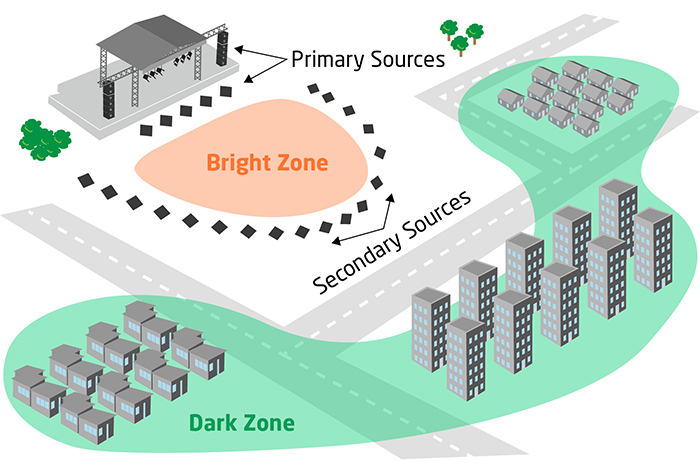DTU collaborates with leading German audio technology company on developing software that can limit noise from outdoor concerts.
In recent years, around the world legislation and regulations to limit noise pollution from traffic, businesses, and events such as outdoor concerts have been tightened up. A collaboration between DTU and the German company d&b audiotechnik aims to find solutions that prevent outdoor music events from bothering neighbours and at the same time give audiences the good music experience they’ve paid for.
The problem of noise from concerts is mainly caused by low frequencies - the thumping bass sound that can be heard from far away. The higher frequencies tend to become absorbed in the atmosphere and do not cause as much noise pollution.
Using sound to prevent noise
The researchers and the company are working on a solution that uses sound to limit the spread of low frequencies. This is done by setting up an extra row of speakers behind the audience at the concert venue, in the so-called bright zone.
From here, a modified version of the sound is sent out to the surroundings which weaken the sound waves being emitted from the PA. The sound from the stage and the modified sound counteract each other: one compresses the air molecules while the other expands them. In doing so, they cancel each other out and prevent the sound of the concert from bothering the neighbours in the ‘dark zone’ without spoiling the great sound for the audience in front of the stage.
“It may sound simple, but there’s a huge range of factors that affect sounds created at outdoor events. These include the kinds of buildings and trees in the area, whether the ground is grass or asphalt, and not least the weather conditions,” says Pierangelo Libianchi, DTU Electrical Engineering, who is responsible for devising the algorithms for the software that will be used.
"We’re very happy with the collaboration with DTU, and it will be fantastic if Pierangelo’s work results in a prototype that can later be developed into an actual product for our customers."
Elena Shabalina, d&b audiotechnik
Initially, Pierangelo Libianchi is focusing on devising a solution that takes into account the factors that affect sound the most, namely temperature and wind.
“When a music festival is held over several days, the weather will change along the way. The wind can pick up and it gets cooler in the evening, causing the sound waves to behave differently. The algorithms have to be able to take that into account,” he says.
DTU well on its way to developing a solution
In recent years, the researchers at DTU Electrical Engineering have worked on the solution by containing the music using an additional row of speakers behind the audience. This is the solution that Pierangelo Libianchi is now developing further. Meanwhile, d&b audiotechnik has produced software that can be used by organizers of outdoor concerts to assess how the noise will affect neighbours. It was therefore a natural fit for d&b to collaborate with DTU.
“DTU has the only international research group with specialized knowledge of how to limit noise from outdoor music events. The university has achieved interesting results from a project in which they examined the spread of unwanted sound from concerts in Tivoli, Copenhagen, among other places,” says Dr. Elena Shabalina, d&b audiotechnik, R&D.
So far, the corona pandemic has only allowed Pierangelo Libianchi to make measurements in a lab setting. However, they have progressed well and he hopes to be able to make measurements outdoors this summer.
“We’re very happy with the collaboration with DTU, and it will be fantastic if Pierangelo’s work results in a prototype that can later be developed into an actual product for our customers. Noise management is a complex and fascinating field, so we are excited to see what’s possible,” says Elena Shabalina.

Illustration: Marianne Rom Andersen